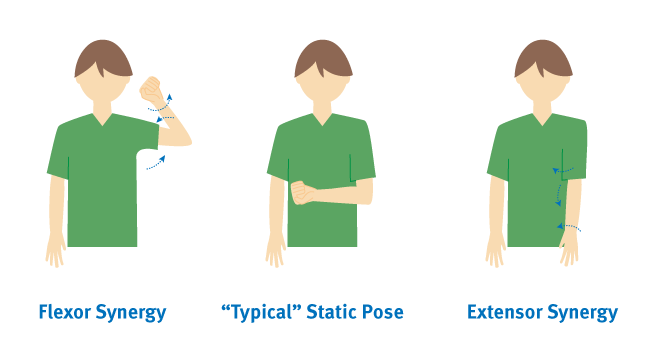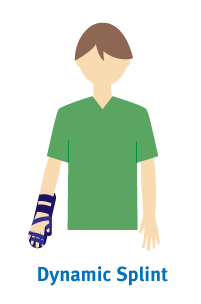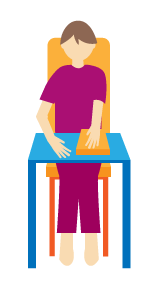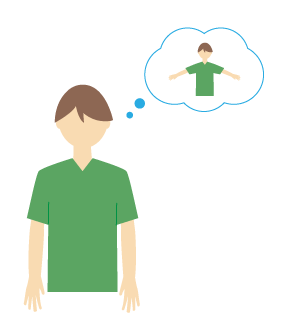
Important Facts About Stage 2 of Stroke Recovery

As stroke survivors recover, most gradually regain strength and movement in the muscles and may eventually enjoy full restoration of function. They may regain reflexes first, then voluntary movements, and may even enjoy full restoration of function eventually. Since the 1970's, the Brunnstrom Approach has helped us divide this post-stroke progress into a series of seven distinct stages. These stages of stroke recovery, which are marked by synergies of different limbs, begin with flaccid muscles and no movement (voluntary or otherwise). However, stage 2 marks an important milestone: the return of movement.
Today, occupational and physical therapists use Brunnstrom's stages to guide their therapeutic approaches. So do the researchers and scientists who develop groundbreaking hardware, software, and other technological innovations to help stroke patients reach that next stage of recovery. As you or your patients navigate this early stage of recovery, it's important to understand which movements to expect, which risks to reduce, and how to help the body heal and progress past Stage 2 of stroke recovery.
What Happens During Stage 2?
Stage 2 marks the redevelopment of some basic limb synergies as certain muscles are stimulated or activated and other muscles in the same system begin to respond. Dr. Subhasish Chatterjee explains that involuntary muscle movements, or reflexes, are the clearest sign of Stage 2, but that some voluntary movements may be possible too.
Involuntary Reflexes
Because the muscles are linked, one activated muscle may lead to partial or complete responses in other muscles. These synergies may limit patient's muscles to certain movements, preventing them from completing the voluntary movements they want to make. However, as neurological development and cell regrowth occurs after a stroke, some new connections may be formed to impaired muscle tissue.
Unfortunately, all reflexive movements aren't necessarily positive for patients' journey toward healing. Because so many impaired muscles still belong to the same synergies, they may react together in harmful ways as neurological signals are sent. For example, upper body motion after a stroke is usually made possible by one of two synergies: flexor and extensor. Some stereotypical postures and abnormal reflexes are outcomes of muscle tightness and restricted mobility after stroke, so therapeutic techniques and devices play huge roles in helping patients navigate this process.
Flexor & Extensor Synergies

Two limb synergies determine a patient’s reactions to cell regrowth during Stage 2 of recovery. The first, the flexor synergy, includes the external rotation of the shoulder, flexion of the elbow, and supination of the forearm. The second, the extensor synergy, includes internal rotation of the shoulder with elbow extension and pronation of the forearm. These synergies may produce one or both of the following postures, which indicate varying levels of brain trauma after stroke.
Coupled with the presence of muscle synergies, between 30 and 40 percent of stroke survivors also experience spasticity. This is a velocity-dependent increase in your normal stretch reflexes, and during Stage 2, it presents as a resistance to passive movement. Stage 2 spasticity contributes to the jerky upper body movements characteristic of the flexor and extensor synergies.
Decorticate Posture
If neurological trauma is severe, it's possible for patients to assume the decorticate posture. During this abnormal and involuntary position, the arms are stiff and bent while the legs stick out straight. Usually, clenched wrists and bent fingers are also pressed against the chest. The University of Maryland Medical Center recommends immediate medical treatment for decorticate posture which could affect both sides of the body and one's ability to breathe.
Decorticate posture is caused by damaged connections between the brain and spinal cord. It's important for patients to receive thorough examinations if they experience this during Stage 2 because decorticate posture may progress to the more serious decerebrate posture. Once this happens, the two postures may alternate or occur simultaneously on different sides of the body.
Decerebrate Posture
Another posture marked by rigid muscles and abnormal movements, decerebrate posture indicates more severe brain damage and may be accompanied by painful muscle spasms. Stroke survivors who assume this reflexive posture will have straight arms and legs, toes pointed downward, and an arched neck and back. Some patients may experience decorticate posture on one side of their body, and decerebrate posture on the other.
The patterns vary from patient to patient, but this posture always means one thing: there has been partial deterioration of the nervous system in the upper brain stem. Spontaneous extension of the limbs is often related to midbrain damage, so it may tell caregivers more about the stroke's effects on individual patients.

Importance of Using Affected Limbs
Unused limbs still need stimulation to maintain or form connections to neurons. Though the nerves and connections that originally controlled your affected limbs may be damaged too much to create voluntary movements, it could still be possible to regain movement in later stages of recovery. In order to leave this possibility open and prevent the body's tendency toward learned nonuse, it's important to continue using and moving your affected limbs and muscles as much as possible.
Neuroplasticity, your brain's ability to form new pathways and control new body parts, also plays a role in this learned nonuse. Quite simply, this term refers to your body's gradual acclimation to mobility loss. If half of your limbs are out of commission while the other half are used more frequently, your muscles may begin to atrophy, preventing new neural connections from forming. Use of impaired limbs after stroke is a good way to maintain or increase the number of neurons connected to these muscles and nerves. This expansion may begin in the first days of recovery or occur years into your progress, so it's important to keep your eyes on your goals.
In fact, The Journal of Neuroscience published a study that proved use of an impaired limb can gradually expand neurological activity over the course of months or years. After spinal cord injury or brain trauma, stroke survivors can take advantage of products like the SaeboFlex to stimulate regrowth and keep impaired muscles active and healthy.
What are the Best Treatments for Stage 2 Synergies and Postures?
You want to begin treatment as soon as you’re stable and ready to. It’s never too early to start retraining the body and brain after stroke, even if patients are experiencing flexor and extensor synergies or decorticate and decerebrate postures. Your goals for treatment should be to maintain range of motion and prevent deformity. You want to try to start active movement and use more of the stroke-affected side. You will also focus on core control, balance, and getting movements to be symmetrical to each other. Also during this stage, occupational therapists will help you with new self-care activities.
As with any exercise program, please consult your healthcare provider before you begin. If you notice increased pain, discomfort, or other troubling systems, stop these exercises immediately and talk to your doctor.
Some of these exercises are particularly useful for patients who want to enter the next stage of recovery:
Positioning
Working on positioning while you are in a hospital bed or in a bed at home will help stimulate and engage your affected side. It’s important to remember to assume upright postures as soon as possible and not consistently stay in bed for full treatment. There are a couple of different positions that you can get to help with stroke recovery during stage 2.
Supine Positioning: You will need a few small pillows for this. Place one small pillow under your shoulder and scapula. This will help promote protraction. Add another pillow under the affected arm to help promote extension. Place an additional pillow under your pelvis to promote anterior pelvic tilt. Place a final pillow under your affected side’s knee to prevent hyperextension.

Lying on the Unaffected Side: For this position, start on your back and roll your hips all the way over to face your unaffected side with your unaffected arm still under you. Put a pillow under your rib cage to help elongate your affected side. Place an additional pillow under your affected upper arm to promote elbow extension and keep the forearm neutral or supinated. Mirroring the upper pillow, place a final pillow under the affected lower leg to help keep the pelvis protracted, hip extended, and knee flexed.

Lying on the Affected Side: This is similar to the above position, but you will roll your hips over to your affected side from lying on your back. Keep your arm and elbow extended, as this will keep your scapula protracted. Put a pillow under your unaffected knee to help with pelvic protraction.

Splinting
Hand splints are widely used to prevent contracture and reduce spasticity. Contracture is a loss of motion over time due to abnormal shortening of the soft tissue structures spanning one or more joints. There are static splints and dynamic splints that can be used for treatment. Hard static splints are used to keep the arm and wrist in a neutral position. Dynamic splints like the SaeboStretch have been found to be more effective, though, in helping contracture. Dynamic splints are moveable and help stretch out muscles, tendons, and ligaments instead of keeping the wrist and fingers static. Dynamic splints can also help reduce joint pain and damage.
Using a stroke rehabilitation splint can help reduce complications while you focus on your recovery. It may also open up new possibilities by restoring the use of your arms faster than not using one at all.

Electrical Stimulation
Neuromuscular electrical stimulation applies small electrical pulses to paralyzed muscles to restore or improve their function. This can help improve connections between the brain and the body’s nerves to improve everyday, voluntary movements. Devices like the Saebo MyoTrac Infiniti uses EMG Triggered Stimulation, which is a combination of biofeedback and electrical stimulation. Devices like these can help you learn new tasks or help modify your existing motor patterns. Auditory and visual cues provide instantaneous feedback, so you can start making the connections again.

Passive Range of Motion Exercises (PROM) and Stretching

Passive exercises are also known as passive range-of-motion (PROM) exercises and can improve your range of motion. Treatment includes how far you can move your joints in different directions. These exercises are considered passive because you don’t exert any effort. Someone like your occupational therapist, physical therapist, or rehabilitation nurse helps you move your muscles and joints through their full range of motion.
When you move your arms and legs though a series of these passive movements, it helps prevent joint contractures and maintain joint flexibility. It’s important that you do these exercises without pain. There are many different flexion and extension exercises you can do to help build arm and leg recovery. Check out Physio Therapy Exercises for helpful how-tos and pictures of passive range-of-motion exercises you can do.
Stroke Recovery Gloves
Like splints, dynamic gloves can also help during stage 2 recovery. The majority of patients with neurological or spinal cord damage from a stroke cannot extend their fingers or move their wrists. Stroke recovery gloves such as the SaeboFlex and the SaeboGlove actually step in to compensate for some of the patient’s biomechanical disadvantages. This orthosis imitates the hand’s natural functions and makes it possible to grasp and release objects—allowing you to perform everyday activities much better than without the glove. The overall goal of the stroke recovery treatment is to make the hand functional again, but it also minimizes joint damage and pain.
Bilateral Exercises
Bilateral rehab exercises train both sides of your body at the same time. The focus is on using both sides of your body together, which will help target your affected side in a functional manner. This will aid neurorehabilitation and get the brain to relearn how to use these affected limbs. An example of a bilateral exercise involves a device called the rocker machine, where patients use the device to rock their hands back and forth in a synchronous, bilateral fashion.
Sitting/Standing Balance/Posture
Hemiparesis or weakness from deficiency on one side of the body is the most frequent symptom and deficit after stroke. This weakness often comes with balance problems. When there are balance impairments, you can increase your risk of falling while recovering. Balance exercises are important in preventing this. From focusing on standing, sitting, and even posture, balance exercises should be one of the first things that needs to be addressed in stage 2 of stroke recovery.
Sitting Balance Positions
There are also a number of sitting positions you can try to help start recovery. Begin by sitting and trying to keep your head and your torso in midline. This will help core balance and symmetry.
Additionally, try sitting symmetrically with both butt cheeks on the chair, not leaning to one side or the other. During each of these positions, keep your hips and knees flexed to 90 degrees and feet flat on the floor. Have your affected arm resting on pillows, with wrist and fingers extended in a functional open position.
As with any new exercise, stroke victims should talk with their healthcare provider before attempting any of these. If the exercises cause pain, the individual should stop.

For standing balance exercises, you can work on shifting your weight from side to side and forward and backward. You can also reach toward your weak side and reach forward with clasped hands to help regain and practice balance movements.
Initiate AROM Exercises
Active range-of-motion exercises (AROM) help improve joint function, which can help recovery in stage 2. Getting to this stage of recovery and starting it can get you well on your way to voluntary movements in stage 3 of stroke recovery. These AROM exercises can help you move each joint through its full range of motion, helping keep your joints flexible, reducing pain, and improving balance and strength.
You and your therapist will go through different range-of-motion exercises and stretches that you can do in the rehab facility and at home. Stretching is especially important for reducing spasticity. Exercises include moving your arm through its full range of motion and gently stretching tight muscles to a point of slight discomfort.

Mental Imagery
Mental Imagery can also help with neuroplasticity, which can be helpful for recovery during stage 2. While the patient is starting to get initial voluntary movements, imagining full movements can help get over the hump to be able to actually perform those movements. Mental rehearsal and visualization of movement can produce effects similar to practicing the actual movements. Imagining hand movements can stimulate restitution and redistribution of brain activity, which accompanies recovery in overall hand function.

Getting Over The Hump Of Stage 2 Of Stroke Recovery
In stage 2 of stroke recovery, a patient starts to redevelop some of their basic limb synergies as certain muscles are stimulated or activated and other muscles in the same system begin to respond. Going through many of these passive and active exercises can help build on this development and get patients to move voluntary movements which is a key part of stage 3 of the Brunnstrom approach.
____________________________________________
Whether you are a caregiver, occupational therapist or even a stroke survivor yourself, Saebo provides stroke survivors young and old with access to transformative, life-changing products. We pride ourselves on providing affordable, easily accessible, and cutting-edge solutions to people suffering from impaired mobility and function. We have several products to help with the stroke recovery and rehabilitation process. From the SaeboFlex, which allows clients to incorporate their hand functionally in therapy or at home, to the SaeboMAS, an unweighting device used to assist the arm to move during daily living tasks and exercise training, we are committed to helping create innovative products for stroke recovery. Check out all of our product offerings or let us help you find which product is right for you.
All content provided on this blog is for informational purposes only and is not intended to be a substitute for professional medical advice, diagnosis, or treatment. Always seek the advice of your physician or other qualified health provider with any questions you may have regarding a medical condition. If you think you may have a medical emergency, call your doctor or 911 immediately. Reliance on any information provided by the Saebo website is solely at your own risk.
All content provided on this blog is for informational purposes only and is not intended to be a substitute for professional medical advice, diagnosis, or treatment. Always seek the advice of your physician or other qualified health providers with any questions you may have regarding a medical condition. If you think you may have a medical emergency, call your doctor or 911 immediately. Reliance on any information provided by the Saebo website is solely at your own risk.


